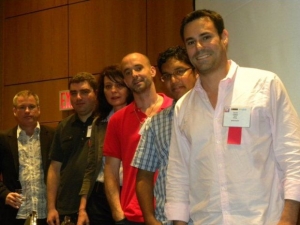David Levy on Social TV Acquisitions (Exclusive)

From left: John McCrea of Tunerfish, Alex Iskold of GetGlue, Nina Alastruey of theChanner, Sean Casey of SocialGuide, Somrat Niyogi of Miso, and David Levy of Philo. All were gathered for the "There's an App for That" panel organized by Social Media News NY at the TV Goes Social Conference Thursday, June 23, 2011 at Fordham Law.
Almost three years ago, David Levy joined five other pioneering Social TV CEOs on a Social TV apps panel organized for the “TV Goes Social” [read coverage] conference at Fordham Law School in New York. Joining Levy, who was CEO of New York-based Philo, a social TV “check-in” application, were: Alex Iskold of GetGlue, Somrat Niyogi of Miso, Nina Alastruey of theChanner, Sean Casey of Social Guide, and John McCrea of Tunerfish.
Turns out, Levy said in an interview Monday with Social TV Daily, Philo was considering a number of paths for the company at that time — including a sale. Ultimately, Philo was acquired by LocalResponse in a deal announced a few months later on Aug. 4, 2011.
Fast forward a year and a half and only Miso and theChanner remain independent after NM Incite announced that it would acquire Social Guide last week and Monday, Viggle announced it would acquire GetGlue in a cash-and-stock deal.
Today, Levy serves as entrepreneur-in-residence at Broadway Video Ventures [LinkedIn Profile], the investment arm of Broadway Video, Lorne Michaels’s production company. We reached out to Levy to get his thoughts on the social TV industry in the context of the two recent deals and a look ahead. We publish this interview, edited for clarity and conciseness.
Q: Where is the social TV industry is today?
A: Clearly, the space is consolidating. Companies are seeing value in having exposure to social TV. Consolidation recognizes the value of the space. Typically, an industry will consolidate to a handful of the most powerful players. The social TV space is just a few years old so this is far from over. This consolidation is part of the process.
Q: Where does the industry need to go in light of the Viggle-GetGLue deal?
A: One company has around 3.5 million registrations and the other has over a million. It’s important for social TV companies to get to scale, and by that I mean, real scale, with tens of millions if not hundreds of millions of active users. No company is mainstream relevant unless it can get to that scale.
The social TV space has not yet evolved to that and so it hasn’t gone mainstream. The most successful social TV company is actually Twitter. The question for those making consumer apps for social TV is: Is what Twitter doing enough and do people want more? Are there more applications needed with functionality that doesn’t exist yet? It remains to be seen what those real features are and what is the real functionality. Twitter owns the conversation, and trying to compete and get people to use something different is going to be a real challenge. My old company had some experience with the conversation around television and ultimately we decided that Twitter had won that component. Is there more people can do with social TV? Sure there is.
Q: So, what is the goal line?
A: The killer utility not yet realized is discovery. GetGlue had been working on that pretty hard and there is real potential there. We are getting more and more channels and networks – there has been an exponential increase in content that is available to watch. That’s not just traditional TV programming like CBS, NBC, and ABC, but YouTube, Netflix, etc. Finding relevant TV content, just like information, is and will be critical and will only become more difficult. If you look at an analogy in the location space, the questions for people using services like Dodgeball and foursquare were: Where are my friends and where am I? This was the initial utility. Next, companies layered on game mechanics. And soon after, deals and specials. But the real killer utility is location discovery and discovery based on what is relevant to me ; that is, discovering places to go based on where I am, where I have been, where my friends have been and so on.
It is likely that social TV will evolve similarly. First, I want to tell friends what I’m watching – implicit in that update is: Come watch with me. Companies like Philo, Miso, and GetGlue did this and layered on game mechanics as well as rewards and contests. But the real opportunity is to get to grand scale and give users real suggestions, real utility, and the answer to the question: What should I watch? When people are looking for something to do and using applications like these they are indicating intent. Indications of intent present a real revenue opportunity for networks and content producers to promote relevant content at a relevant time when intent is high.
In the social world, information relevance is determined by how many people are pointing to a piece of information, while in the web (only) world information relevance is determined by how many websites are pointing to a piece of information. So we are experiencing a change or an augmentation of how we determine the relevance of information and in the methods we use to find information.
Coincidentally, discovery is to social and mobile what search is to the web.
